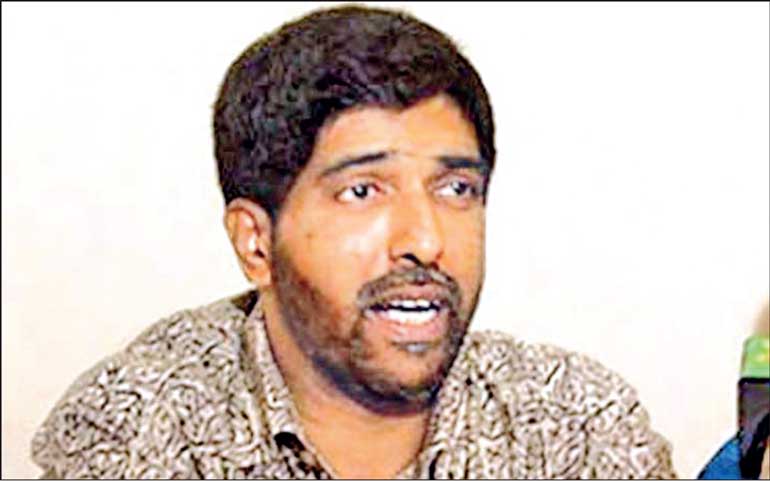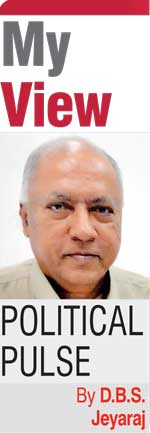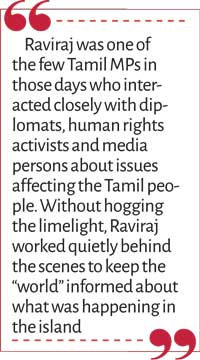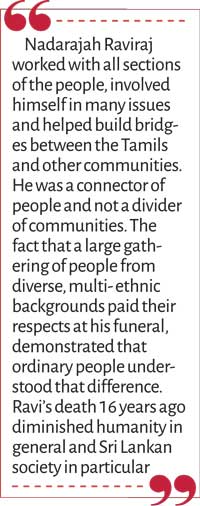Sunday Nov 23, 2025
Sunday Nov 23, 2025
Wednesday, 9 November 2022 00:13 - - {{hitsCtrl.values.hits}}

Nadarajah Raviraj
The election of Mahinda Rajapaksa as Sri Lanka’s fifth executive president in November 2005 saw the war against the Liberation Tigers of Tamil Eelam (LTTE) intensifying. The new president appointed his US citizen younger brother Gotabaya Rajapaksa as the all-powerful Secretary of Defence. Gotabaya appointed retired colonel of the Sri Lankan army, his erstwhile comrade at arms and fellow Anandian, General Sarath Fonseka as the Army Commander. Thereafter the war effort progressed under the political, administrative and military leadership of the President, Defence Secretary and Army Chief respectively. Ultimately the LTTE was militarily defeated on the banks of the Nandhikkadal lagoon in May 2009.
brother Gotabaya Rajapaksa as the all-powerful Secretary of Defence. Gotabaya appointed retired colonel of the Sri Lankan army, his erstwhile comrade at arms and fellow Anandian, General Sarath Fonseka as the Army Commander. Thereafter the war effort progressed under the political, administrative and military leadership of the President, Defence Secretary and Army Chief respectively. Ultimately the LTTE was militarily defeated on the banks of the Nandhikkadal lagoon in May 2009.
The Rajapaksa Government believed in the credo of the end justifying the means. Therefore the Rajapaksa regime resorted to several “unorthodox” measures during the war. One of these was what is described in human rights parlance as “officially sanctioned unofficial executions”. Assassination became a weapon of the dirty war. Two of the earliest victims were two members of Parliament belonging to the Tamil National Alliance (TNA).
TNA national list MP Joseph Pararajasingham was killed in Batticaloa on 24 December 2005. He was shot dead by assassins in church after partaking of Holy Communion during service on Christmas Eve. TNA Jaffna district MP Nadarajah Raviraj was murdered in Colombo on 10 November 2006. He along with his Police bodyguard was gunned down in broad daylight by unknown killers on a public road.
President Ranil Wickremesinghe who was the Leader of the Opposition and the head of United National Party (UNP) at the time of Raviraj’s killing condemned the assassination strongly. Wickremesinghe then said, “Within a year of parliamentarian Joseph Pararajasingham’s assassination, Raviraj has been killed. This is a threat to democracy. We strongly condemn this cowardly act and urge the Government to take legal action to bring the killers to justice besides providing adequate security measures to Tamil parliamentarians.”
Pararajasingham and Raviraj
Years later, the UN High Commissioner for Human Rights (OHCHR) investigation report on Sri Lanka (OISL) presented at the 30th session of the UN Human Rights Council (UNHRC) in September 2015 made specific references to the assassination of Pararajasingham and Raviraj.
The 16th death anniversary of Nadarajah Raviraj falls tomorrow on 10 November. Nadarajah Raviraj was personally known to me. He was one of the many political leaders known to me on either side of the ethnic divide who were killed during the course of Sri Lanka’s protracted war. This column therefore re-visits the life and death of Nadarajah Raviraj this week – with the aid of some earlier writings – in a bid to revive memories of the man who was gunned down most cruelly at the age of 44, sixteen years ago.
Manningtown, Narahenpita
D-day or the day of death as 10 November 2006. The TNA parliamentarian from Jaffna district and his bodyguard Police Sgt. Lokuwellamurage Shantha Laxman Lokuwella from Gampaha were shot dead in broad daylight at 8:39/40 a.m. in Colombo. The shooting occurred close to Raviraj’s residence in Manningtown, Narahenpita.
8:39/40 a.m. in Colombo. The shooting occurred close to Raviraj’s residence in Manningtown, Narahenpita.
The spot where the shooting occurred was in close proximity to the Telecommunications Regulatory Authority and the Registrar of Motor Vehicles Department. The Jaffna MP had returned home after a discussion – interview on “Derana” TV from 7 a.m. to 7:30 a.m. He had quickly changed clothes, had breakfast and started out again to his law office.
Raviraj, a lawyer by profession, had his own law firm: “Raviraj and Associates”. Though the MP had his own driver, the man was on leave. The driver had requested a further extension of leave a few days before the killing. According to Raviraj’s brother in law the MP had then told the driver good – humouredly, “Even if I die you can have your leave.” The TNA Parliamentarian had first tried to use his wife’s car but finding the battery had run down chose to use his own vehicle.
Motorcycle JE 3507
Raviraj had asked his bodyguard Sgt. Lakshman, a native of Gampaha, to get in and climbed onto the driver’s seat. The Toyota Land Cruiser Prado bearing the No. WP KE 1279 was then slowly driven along Martha Road by Raviraj. The vehicle was turning into Elvitigala Mawatte when a motorcycle numbered JE 3507 came near from the opposite side. Two men with helmets were on it. One got down from the pillion, removed his helmet, went across and stood on the pavement. He had a shoulder bag.
Raviraj’s vehicle was cruising along very slowly when the man tore apart the bag he was carrying and started firing. The weapon was a T-56. The assassin did not pull the gun out but fired while it was yet inside the bag. The assassin fired away at point blank range on Raviraj’s vehicle from the front, side and rear. An entire magazine was exhausted in the firing. He then ran quickly and climbed on to the motorcycle pillion again.
The assassins had then turned into Martha Road and sped away. The bag containing the T-56 as well as the helmet of one rider were found on the side of the road. Police also stated that a three-wheeler parked close to the spot had also driven away after the shooting. It is suspected that the three-wheeler driver was a “look-out” for the assassins and had tipped them off by mobile telephone about Raviraj’s vehicle approaching.
Colombo National Hospital
Raviraj was hit five times and Lokuwella eight times. Both victims were taken to Colombo National Hospital speedily. Lokuwella was pronounced dead upon admission. Raviraj was in critical condition and urgent surgery was done but Raviraj was dead at 9:20 a.m. Hospital sources said the MP was “clinically dead” even when admitted. Thus ended the life of Nadarajah Raviraj.
National Peace Council Executive-Director Jehan Perera described Raviraj’s political role in the following manner when the MP was killed: “Raviraj was a Tamil leader who helped to educate the non-Tamil population about the perspectives of the Tamils and their sufferings. On Tuesday November 14 he had agreed to be a speaker at a Religious-Political Dialogue organised by several civic organisations. He was friendly with all, and always prepared to engage with others, even with those of a very different political mind set. Although the Sinhala language skills at his disposal were limited, he courageously made use of them to debate the representatives of the nationalist Sinhalese political parties and provide another perspective on current and national issues. With his killing this important avenue of information is likely to close for both the general public and the international community to whom he spoke with a measure of credibility.”
important avenue of information is likely to close for both the general public and the international community to whom he spoke with a measure of credibility.”
Native of Chavakachcheri
Nadarajah Raviraj, born on 25 June 1962, was a native of Chavakachcheri in the Thenmaratchy sector of Jaffna. His father was a schoolmaster at Chavakachcheri Hindu College in Sangathanai. His mother taught at Hindu Ladies College, Chavakachcheri. Raviraj was an old boy of Driebergs College, Chavakachcheri and St. Johns College, Jaffna. Friends recall with affectionate nostalgia that Raviraj generally known as Ravi was also nicknamed “kilangu” (potato) in his student days.
Raviraj passed out as a lawyer and took his oaths in 1987. He joined the Attorney-General’s Dept. in 1990 and worked there till 1993. He quit the AG’s Dept. in 1993 and became a human rights lawyer attached to the Home for Human Rights. He worked there till 1996. Thereafter he began private practice and soon set up his own law office, Raviraj and Associates. Raviraj was involved in human rights work from 1984 onwards even during his law college days.
Tamil United Liberation Front
Raviraj became enamoured of democratic politics at a time when most Tamils of a younger generation were aligning with militant groups. He joined the Tamil United Liberation Front (TULF) and worked actively for the party along with other young Tamil lawyers like former Jaffna mayor Pon. Sivapalan and ex-Batticaloa MP and former Eastern Provincial Minister K. Thurairajasingham.
Raviraj owed his rise in politics to TULF leader Veerasingham Anandasangaree who regarded his younger colleague as a protégé. Sangaree promoted Raviraj within the party. Raviraj became TULF central committee member in 1990. In 1998 he was appointed legal adviser to the party. Raviraj was made TULF Politbureau Member in 2000 and in 2001 became Administrative Secretary of the party.
The TULF of an earlier era faced great danger at the hands of the Liberation Tigers of Tamil Eelam (LTTE). Other militant Tamil groups supposedly functioning as “half-democratic” parties were also not well-disposed towards the grand old democratic party of Sri Lankan Tamils. It was amidst great physical danger that the TULF contested the Jaffna Municipality in 1998. Raviraj too was on the list. The TULF with its slogan of “unarmed democracy” (Aayuthamatra Jananayagam) topped the polls in Jaffna despite not having resources like other Tamil parties. Raviraj became a municipal councillor.
Jaffna Mayor
Sarojini Yogeswaran became Jaffna mayor and was shot dead by the LTTE. Pon. Sivapalan then succeeded her. Sivapalan along with Jaffna military commander Brigadier Mendis and several others were killed when the LTTE exploded a claymore mine concealed in the ceiling. The mayoral aspirant Pon. Mathimugarajah was assassinated by the LTTE in front of the Nallur Kandaswamy temple.
In spite of the danger involved Raviraj backed up by Anandasangaree came forward to don the mayoral mantle. Raviraj was appointed deputy mayor in 1998. Instead of becoming Mayor immediately Raviraj functioned as acting mayor. He was the de-facto and not de-jure mayor for a while. Raviraj adopted this razor’s edge stance and managed to survive politically and physically. In October 2000 Raviraj contested the Parliamentary elections on the TULF ticket but failed to win a seat. In 2001 Raviraj was formally appointed as Jaffna Mayor. But within months Raviraj was elected to Parliament and resigned Mayoral office.
Tamil National Alliance
By 2001 there was a sea change in Tamil “moderate” politics. The TULF, Tamil Congress, EPRLF and TELO joined hands and formed a loose alliance known as the Tamil National Alliance. They started moving close to the LTTE and began toeing the tiger line.
Member of Parliament
The newly formed TNA did well at the polls. Raviraj too won and became a Member of Parliament for the first time in 2001 December. There was however a split in the TULF when the old warhorse Anandasangaree fell foul of the LTTE which wanted him ousted. The TNA was now fast becoming a puppet of the LTTE. Sangaree resisted LTTE domination and paid the price as most of his colleagues and followers deserted him and paid pooja to the tigers.
The unkindest cut for Sangaree was the “transformation” of Raviraj. The young MP had initially backed his political mentor but gradually parted ways with his senior colleague.
In 2004 April Raviraj was re-elected as Jaffna district MP but Anandasangaree was defeated in an “undemocratic” poll conducted through dubious means. Raviraj soon became a rising star in the TNA which contested under the house symbol of the Ilankai Thamil Arasu Katchi (ITAK).
One of Raviraj’s strong points was his fluency in Tamil, English and Sinhala. This enabled him to participate fully in Parliament debates, media discussions and interviews and public meetings. He was a forceful speaker and conveyed his views precisely and clearly. He was capable of quick repartees and often made pithy and pungent comments. He also participated in demonstrations particularly those concerning freedom of expression. Raviraj had many friends among the Colombo media. He participated in many TV shows in all three languages. He was perhaps the best known face among TNA Parliamentarians to the “Sinhala” South.
In Canada
Raviraj was in Canada many years ago and I heard him speak at a public seminar on the plight of Tamils in Sri Lanka. Raviraj was the last speaker. There were a couple of Canadian mainstream MPs at the meeting. As is usual among Western politicians, who “grace” minority community occasions just to keep up “appearances”, the two gentlemen began moving out as Raviraj was on the rostrum. The young Tamil MP was not fazed and made a public appeal that both MPs should not leave but sit and listen to his speech. Taken aback both men promptly returned to their seats, tuned in and afterwards engaged in long discussions with the Sri Lankan Parliamentarian.
I also remember that Raviraj could not have dinner with me as arranged earlier because his departure from Toronto had to be expedited due to an urgent matter. I was not at home when he called to inform me of the sudden change of plan. After returning to Colombo Raviraj was courteous enough to telephone me and apologise profusely.
The conflict in Sri Lanka began escalating after Mahinda Rajapaksa became President in November 2005. The war conducted against the Liberation Tigers of Tamil Eelam (LTTE) resulted in great hardship for the Tamil people. The basic human rights of the Tamil people were violated with impunity during those days of war. “Terror” was on the rise.
Civil Monitoring Committee
Raviraj was in the forefront of those resisting this creeping state of terror. He joined hands with those of different political beliefs and ethnicities to fight for common causes. A case in point was his active involvement in the Civil Monitoring Committee (CMC) set up to monitor extra-judicial executions, disappearances and abductions. Raviraj worked with people like Mano Ganesan, Siritunga Jayasuriya, Vasudeva Nanayakara, Dr. Vickramabahu Karunaratne, and Appapillai Vinayagamoorthy in this regard.
I also know for a fact that Raviraj was one of the few Tamil MPs in those days who interacted closely with diplomats, human rights activists and media persons about issues affecting the Tamil people. Without hogging the limelight, Raviraj worked quietly behind the scenes to keep the “world” informed about what was happening in the island. Raviraj also participated in conflict resolution workshops hosted by Institute of Federalism in Switzerland, Konrad Adenauer Foundation in Germany and Peace Institute in Austria.
UNHCR office demonstration
Raviraj along with a few other MPs was the livewire of the TNA then. The TNA then adopted a more militant yet non-violent stance in espousing the Tamil cause. After many non-violent demonstrations in Parliament the TNA began taking to the streets to articulate Tamil grievances. A demonstration opposite the UNHCR office in Bullers Road was to be the first of a new series of envisaged protests.
Once again Raviraj played a crucial role in organising and conducting the demonstration. 19 of the 22 TNA Parliamentarians participated. Apart from handling logistics Raviraj’s voice could be heard shouting slogans and demands loudly in all three languages. He also interacted with the media and obtained much publicity for the event. Given the prevailing political culture of that time where all Tamil dissent was ruthlessly suppressed a voice such as that of Raviraj’s too had to be silenced from the viewpoint of those wielding power in the Democratic Socialist Republic of Sri Lanka. And so the life of Raviraj was extinguished on 10 November.
Final media interview
Pronouncements and views expressed on one’s deathbed or prior to death are treated as sacrosanct. Raviraj did not know that he was going to be shot at 8:40 a.m. and that he would die at 9:20 a.m. on 10 November. His final media interview was between 7:30 to 8 a.m. that same morning. Some of the views he expressed then could be regarded as his last testament and will (in political terms).
What does Raviraj tell “Derana”?
“The people in the north-east aspire to live together. They aspire for the merger of the two provinces; it is a basic human right of those people. In the ancient times, there were Sinhala and Tamil kingdoms in Sri Lanka. It is not new to our people. That is mainly an area of Tamils from ancient times. It does not mean that we want to divide the country. We believe that north and east be considered as one unit. That should be the base if to find a solution to the ethnic crisis.”
“In 1947 when India achieved independence, Mohamed Ali Jinnah demanded Pakistan to be separated. We asked for 50-50 and then a Federal system and now the LTTE is fighting for separate state. However, as politicians we still believe in a united country.”
Those who knew Raviraj intimately would realise that these last words of Raviraj came from his heart. The real Raviraj was the man who boldly distanced himself from the LTTE on TV and said, “It does not mean that we want to divide the country” and also observed “now the LTTE is fighting for separate state. However, as politicians we still believe in a united country.” This then was the real Raviraj.
Connector and not divider
Nadarajah Raviraj worked with all sections of the people, involved himself in many issues and helped build bridges between the Tamils and other communities. He was a connector of people and not a divider of communities. The fact that a large gathering of people from diverse, multi- ethnic backgrounds paid their respects at his funeral, demonstrated that ordinary people understood that difference. Ravi’s death 16 years ago diminished humanity in general and Sri Lankan society in particular.
(The writer can be reached at [email protected].)